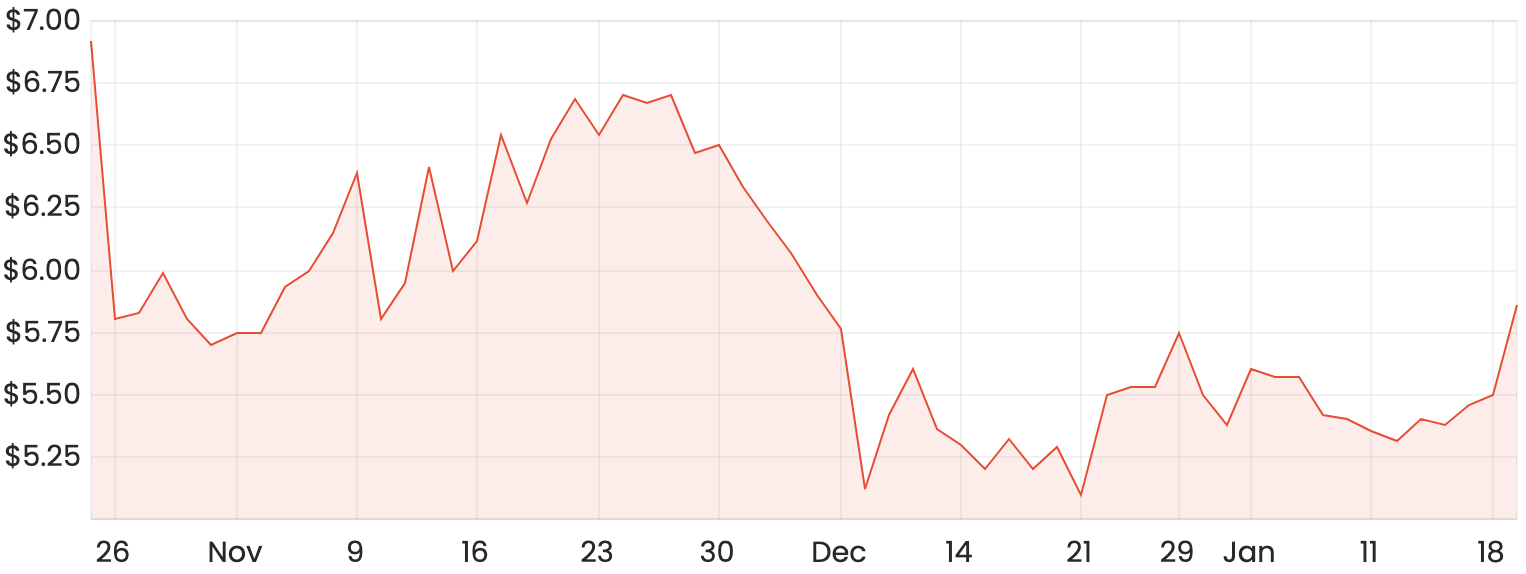Shares in e-commerce beauty retailer Adore Beauty Group Ltd (ASX: ABY) have languished more than 10% below their original $6.75 issue price since listing on the ASX in October last year.
Adore Beauty shares didn’t come cheap to start with, but fund managers were more than willing to pay 3.9x forecast CY20 (calendar year) revenue and over 95x forecast EBITDA on a per-share basis.
The timing of the IPO was also fairly unfortunate. Adore listed on the ASX just a week prior to the first COVID-19 vaccine announcement, which saw investors rotate out of COVID beneficiary stocks into recovery sectors.
All this being said, does the Adore Beauty share price represent a good buying opportunity at today’s levels?
ABY share price chart

Adore Beauty’s background
Adore is a pure-play online beauty retailer that serves over 18.5 million users in Australia and New Zealand through its e-commerce platform.
Prior to listing on the ASX last year, private equity firm Quadrant Growth held a 60% stake in the company.
After holding this position for just one year, Quadrant sold 40% of its shares for $137.2 million but remains as Adore’s top shareholder, holding 32.51% of the shares on issue.
According to management, Adore’s business model revolves around three key elements that help to drive a powerful network effect:
- Range authority: Adore has an extremely wide range of products on offer across prestige, professional, niche, and masstige brands, with over 230 brands and more than 11,000 products.
- High-quality transaction experience: Individualised shopping experiences are created through AI-led recommendations resulting in an engaging purchasing journey.
- Data-enriched customer engagement: Through an engaging integrated platform, Adore is able to increase loyalty and size of spend through personalised marketing campaigns driven by increasing amounts of customer data.
Management has indicated that the company’s competitive moat is in the form of a compelling product range (including private label), customer-led engagement, and a seamless transaction experience and fast delivery.
While these are certainly good attributes to have as a retailer, I’m not sure if I would personally consider these aspects as a strong form of a competitive advantage as they’re quite easily replicable by competitors.
Further growth will be driven by the launch of a new mobile app, increased brand awareness, and a growing total addressable market through expanding into new markets and adjacent categories.
Past financial performance
Past financial data is limited, but going purely off the prospectus, Adore has demonstrated some strong sales growth over the last few years.
I notice that marketing costs have been increasing as a proportion of revenue over the last three years and the company typically achieves a fairly underwhelming gross margin of around 31%.
Moving further down the income statement, the company generated net profit after tax (NPAT) of $2.5 million in FY20 with forecast earnings for 1H FY21 of $1.8 million.
Adore management upgraded guidance figures in December last year after a better than expected Black Friday weekend.
First-half FY21 forecast revenue is expected to be around $95.2 million (up 7% from prospectus figures), and the improvement will likely have a positive impact on the EBITDA forecast for the period as well.
Adore’s valuation
I’ll start by mentioning that Adore is operating in a large, growing addressable market that presents itself as a big opportunity.
According to a study from Frost & Sullivan, the Australian beauty and personal care market (offline and online) generated sales of around $10.9 billion in CY19. This is expected to grow at a compound annual growth rate (CAGR) of 3.6% per year.
However, this study also indicated that the online market had only achieved 7% penetration in CY19 and represents a further growth opportunity as a COVID-19-related acceleration towards online channels occurs over these next few years.
All of this aside, if you choose to value Adore’s shares purely from some fundamental metrics such as price-to-sales (P/S) or price-to-earnings (P/E), you’ll probably find it’s hard to argue for a bargain.
I’m going to assume that Adore will not be able to generate as much revenue in H2 FY21, mainly due to the Christmas and Black Friday period which is reflected in the first half of the financial year.
If Adore could arbitrarily generate $70 million revenue in H2 FY21, that would put the company on an annualised figure of $165.2 million. I’ll give this valuation an added margin of safety by assuming the company will be able to increase its NPAT to $5 million in FY21.
This would put Adore’s shares on a forward P/S and P/E multiple of 3.3x and 110x, respectively.
Summary
I’d personally need to see a bit more of a track record before I’d consider buying shares in Adore Beauty.
NPAT has gone sideways for the last few years and margins are fairly low, so I’d want to see how both of these metrics improve as the company executes its growth strategy.
This aside, COVID-19 may have rapidly accelerated the shift to online in this type of industry, and Adore might just be in the perfect position to benefit from it.
If you’re after more share ideas, click here to read this article: 3 ASX tech shares to add to your 2021 watchlist.









